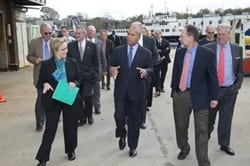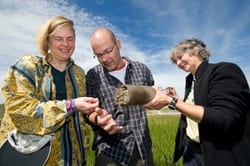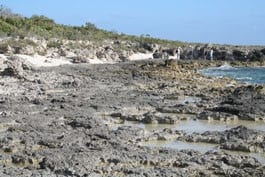Press Room
WHOI and the Consortium for Ocean Leadership have awarded a contract to Pro-Oceanus Systems, Inc., of Bridgewater, Nova Scotia, Canada, to provide Partial Pressure of CO2, or p(CO2) , air-sea instrument packages for the Coastal and Global Scale Nodes component of the Ocean Observatories Initiative program.
Woods Hole Oceanographic Institution (WHOI) scientists have discovered that bacterial communication could have a significant impact on the planetÃÂs climate.
The Woods Hole Oceanographic Institution (WHOI) hosted a visit Wednesday, October 12, by Massachusetts Governor Deval Patrick, marking his first visit to the Cape-based non-profit ocean research, engineering, and education organization. “The Institution is honored to host the governor,” said…
The Woods Hole Oceanographic Institution (WHOI) has signed a $1.18 million agreement with the Flatley Discovery Lab in Charlestown, Mass., to investigate and supply marine microbial extracts as possible treatments for cystic fibrosis (CF).
Scientists from the Marine Biological Laboratory (MBL) and the Woods Hole Oceanographic Institution (WHOI) were recently awarded a $1.2 million collaborative grant from the National Science Foundation (NSF) for studies on the role of sulfur-oxidizing bacteria in salt marsh nitrogen and carbon cycling. The fieldwork will be conducted at the Plum Island Ecosystem Long-Term Ecological Research (LTER) site on the North Shore of Boston.
New evidence of sea-level oscillations during a warm period that started about 125,000 years ago raises the possibility of a similar scenario if the planet continues its more recent warming trend, says a research team led by the Woods Hole Oceanographic Institution (WHOI).
The New Bedford Whaling Museum is the backdrop for a free community event ÂPioneering New Ocean Science Frontiers on Saturday, September 17, from 10 a.m.  2 p.m., co-sponsored by the Woods Hole Oceanographic Institution and the Consortium for Ocean Leadership. The Whaling Museum is located at 18 Johnny Cake Hill, New Bedford, Mass.
In a detailed assessment of the Deepwater Horizon oil spill, researchers led by a team from the Woods Hole Oceanographic Institution (WHOI) have determined that the blown-out Macondo well spewed oil at a rate of about 57,000 barrels a day, totaling nearly 5 million barrels of oil released from the well between April 20 and July 15, 2010, when the leak was capped. In addition, the well released some 100 million standard cubic feet per day of natural gas.
An international team of researchers, including physical oceanographers from the Woods Hole Oceanographic Institution (WHOI), has confirmed the presence of a deep-reaching ocean circulation system off Iceland that could significantly influence the oceans response to climate change in previously unforeseen ways.
On Monday, Aug. 15, U.S. Senator Scott Brown visited the Woods Hole Oceanographic Institution (WHOI), the world-renowned research and education organization based on Cape Cod. The visit was Browns first to WHOI.
WHOI researchers have embarked on a 10-day mission to provide the first underwater, 3-D optical survey of ships sunk by German U Boats during World War II off the North Carolina coast.
Changes in ocean chemistry due to increased carbon dioxide (CO2) emissions are expected to damage shellfish populations around the world, but some nations will feel the impacts much sooner and more intensely than others, according to a study by scientists at Woods Hole Oceanographic Institution (WHOI).
On Sunday, August 7, from 11 a.m. to 3 p.m., the Woods Hole Oceanographic Institution (WHOI) will host a free community event featuring a rare opportunity to tour the oceanographic research vessel Knorr. The ship is best known as the one used in the discovery of the wreck of the Titanic and of the first hydrothermal vents. Visitors to the event will also be able to attend talks by one of KnorrÂs former captains and scientists who have used it to study the worldÂs ocean..
In the first published study to explain the role of microbes in breaking down the oil slick on the surface of the Gulf of Mexico, Woods Hole Oceanographic Institution (WHOI) researchers have come up with answers that represent both surprisingly good news and a head-scratching mystery.
Ten writers and multimedia science journalists from the U.S., Canada, France, Great Britain and South Korea have been selected to participate in the competitive Woods Hole Oceanographic Institution (WHOI) Ocean Science Journalism Fellowship program. The program takes place September 11-16,…
When a group of five high school students embarked on Project Shiphunt, an expedition in search of lost shipwrecks, in May in Lake Huron, the Woods Hole Oceanographic Institution’s Advanced Imaging and Visualization Lab (AIVL) was there, surveying and capturing 3D footage of the finds. The work was conducted as part of Project Shiphunt, an initiative developed by Sony and Intel Corp and led by National Oceanic and Atmospheric Association (NOAA).
A Woods Hole Oceanographic Institution (WHOI) scientist, analyzing ancient plankton DNA signatures in sediments of the Black Sea, has found for the first time that the same genetic populations of a virus and its algal host can persist and coexist for centuries. The findings have implications for the ecological significance of viruses in shaping algae ecosystems in the ocean, and perhaps fresh water as well.
Taking another major step in sleuthing the 2010 Deepwater Horizon oil spill, a research team led by the Woods Hole Oceanographic Institution (WHOI) has determined what chemicals were contained in a deep, hydrocarbon-containing plume at least 22 miles long that WHOI scientists mapped and sampled last summer in the Gulf of Mexico, a residue of the Deepwater Horizon oil spill.
The Woods Hole Oceanographic Institution and the Consortium for Ocean Leadership announced Hydroid will provide Autonomous Underwater Vehicles (AUVs) and docking stations to support the Pioneer Array of the Ocean Observatories Initiative (OOI).
Woods Hole Oceanographic Institution (WHOI) researchers have filled an important gap in the study of tunicate evolution by genetically sequencing 40 new specimens of thaliaceans, a gelatinous type of tunicate. Their study was featured on the cover of the June issue of the Journal of Plankton Research.



